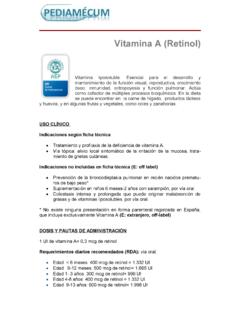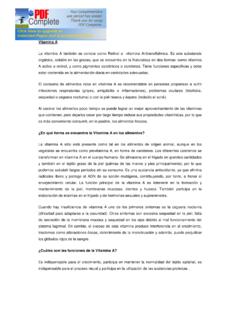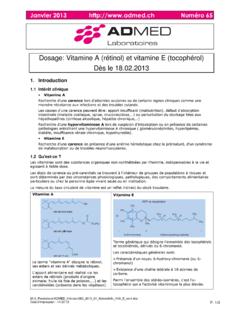Transcription of Serum retinol concentrations for determining the ...
1 retinol is the predominant circulating form of vitamin A in the blood. In response to tissue demand, it is released from the liver in a 1:1 ratio with its carrier protein, retinol -binding protein (1). In the blood, this complex combines with transthyretin (2). Specific receptors on target cell surfaces or nuclei bind this complex or its active metabolites, thereby regulating many critical functions in the body, including vision, epithelial tissue integrity, and the expression of several hundred genes (2). Serum retinol levels reflect liver vitamin A stores only when they are severely depleted (< mol/g liver) or extremely high (> mol/g liver) (1).
2 Between these extremes, Serum retinol is homeostatically controlled and thus not always correlated with vitamin A intake or clinical signs of deficiency. Consequently, Serum retinol is not useful for assessing the vitamin A status of individuals and may not respond to interventions. Rather, the distribution of Serum retinol values in a population and the prevalence of individuals with Serum retinol values below a given cut-off can provide important information on the vitamin A status of a population and may reflect the severity of vitamin A deficiency as a public health problem (3), especially when the degree of underlying infection or inflammation is taken into account.
3 Serum retinol values are most often measured in young children, a group highly vulnerable to deficiency (3). Deficiency of vitamin A is associated with significant morbidity and mortality from common childhood infections and is the world s leading preventable cause of childhood blindness (3). Inside Background Scope and Purpose This document aims to provide users of the Vitamin and Mineral Nutrition Information System (VMNIS) with information about the use of Serum retinol for assessing the prevalence of vitamin A deficiency in populations.
4 It is a compilation of the current World Health Organization (WHO) recommendations on the topic and summarizes, from the three documents VMNIS | Vitamin and Mineral Nutrition Information System Background 1 Description of Technical Consultation 2 Recommendations 2 Summary Development Acknowledgements 4 Plans for Update 4 References 5 4 Scope and Purpose 1 VMNIS | 1 Serum retinol concentrations for determining the prevalence of vitamin A deficiency in populations WHO/NMH/NHD/ VMNIS | 2 Micronutrients Indicators Serum retinol concentrations for determining the prevalence of vitamin A deficiency in populations
5 Table 1 Prevalence of low Serum retinol ( mol/l or below) to define a public health problem and its level of importance among children 6-71 months of agea described below, the cut-offs for defining vitamin A deficiency and its severity at the population level, and the chronology of their establishment. The cut-offs included in this summary are essential for identifying populations most at risk of deficiency and in need of intervention. Assessment of Serum retinol permits both the monitoring of trends of vitamin A deficiency as well as the evaluation of the impact of interventions.
6 Such assessments allow for the measurement of progress towards international goals of micronutrient deficiency control. Description of Technical Consultation This document compiles current WHO recommen-dations from the following publications: Vitamin A deficiency and xerophthalmia: Report of a joint WHO/USAID meeting (4). This document was published in 1976 following a meeting on vitamin A deficiency and xerophthalmia that was convened jointly by WHO and USAID in Jakarta, Indonesia, 25-29 November 1974.
7 The purpose of the meeting was to discuss priorities for research and vitamin A programmes. Meeting attendees made several recommendations concerning the assessment of vitamin A status and discussed the feasibility of vitamin A deficiency prevention measures. A protocol for the treatment of emergency cases of xerophthalmia was also developed. Control of vitamin A deficiency and xerophthalmia: Report of a joint WHO/UNICEF/USAID/Helen Keller Recommendations The prevalence in the population with low Serum retinol ( mol/l or below) can be used to assess the severity of vitamin A deficiency in most age groups as a public health problem, as shown in Table 1.
8 International/IVACG meeting (5). This document was published in 1982 following a meeting also held in Jakarta, Indonesia, 13-17 October 1980, to review progress that had been made in the establishment of measures to control vitamin A deficiency and xerophthalmia that had been instituted since the preceding meeting held in 1974. Indicators for assessing vitamin A deficiency and their application in monitoring and evaluating intervention programmes (3). This document was published in 1996 following a technical consultation held in Geneva, Switzerland, 9-11 November 1992.
9 The consultation was attended by academic and governmental experts in vitamin A deficiency. The stated objectives of the consultation were: 1) to identify indicators and establish cut-off points for assessing subclinical vitamin A deficiency in populations; 2) to determine which indicator, or combinations of indicators, may be useful in populations with vitamin A deficiency at levels that pose an important public health problem; 3) to discuss, according to age and/or sex, which groups are most appropriate for assessment using different indicators.
10 And 4) to consider the characteristics of the indicators and their usefulness given different surveillance objectives. Degree of public health problemb Mild Moderate Severe Prevalence of low Serum retinol ( mol/l or below) 2-9% 10-19% 20 % or more a Source: reference (3) b These cut-offs do not apply in infants younger than 6 months of age VMNIS | 3 Micronutrients Indicators Serum retinol concentrations for determining the prevalence of vitamin A deficiency in populations Prior to the 1996 publication, a 5% or higher prevalence of Serum retinol values of mol/l or lower among children younger than six years of age had been used to define a deficient population and served to corroborate xerophthalmic findings (4,5).
















